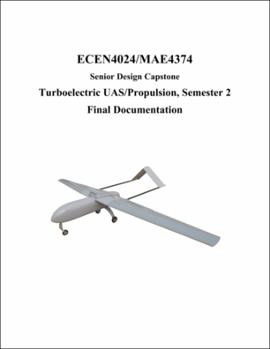| dc.contributor.author | Lewis, Max | |
| dc.contributor.author | Cobb, Andrew | |
| dc.contributor.author | Replogle, Cole | |
| dc.date.accessioned | 2021-03-25T18:52:12Z | |
| dc.date.available | 2021-03-25T18:52:12Z | |
| dc.date.issued | 2020-04-23 | |
| dc.identifier | oksd_lewis_HT_2020 | |
| dc.identifier.uri | https://hdl.handle.net/11244/329062 | |
| dc.description.abstract | Turboelectric propulsion is a relatively new field of study in the world of unmanned aerial system propulsion. Conceptually, it is a simple concept: a turboshaft is mechanically coupled to a generator, converting the mechanical energy from the turboshaft to electrical energy. This electrical energy is then conditioned to desired values and then distributed to propulsors. The interest in turboelectric energy is in the properties of the hydrocarbons used. Turboelectric systems have been observed to reduce overall fuel consumption and emissions while demonstrating comparable ranges, speeds, and versatility to traditional propulsion methods. Essentially, turboelectric systems provide a more environmentally friendly and economic solution to aviation problems while retaining performance. Since the system features electric conditioning, there exists the option for versatility in the electrical side of things, such as the implementation of batteries and switching circuits. | |
| dc.description.abstract | Turboelectric propulsion can exist at multiple scales as well. From smaller UAV applications, like the one utilized in this project, to larger, manned aircraft on the scale of a Cessna aircraft and even, at least conceptually, very large passenger aircraft such as the NASA N3-X concept aircraft. | |
| dc.description.abstract | This project tests three turboelectric systems at different levels of power generation: a five-kilowatt system, a seven-kilowatt system, and a thirteen-kilowatt system (power generation is on the UAV scale) and seeks to demonstrate efficiency, both mechanically and electrically, performance, scalability, power conditioning, and electrical versatility. | |
| dc.description.abstract | This project's funding comes from the C3 FirePoint competition, sponsored by the United States Army Combat Capabilities Development Command Aviation and Missile Center, and after providing concepts to the competition and advancing to the next round of the competition, this project has a budget of $10,000. | |
| dc.format | application/pdf | |
| dc.language | en_US | |
| dc.rights | Copyright is held by the author who has granted the Oklahoma State University Library the non-exclusive right to share this material in its institutional repository. Contact Digital Library Services at lib-dls@okstate.edu or 405-744-9161 for the permission policy on the use, reproduction or distribution of this material. | |
| dc.title | Turboelectric UAS/propulsion, Semester 2: Final documentation | |
| osu.filename | oksd_lewis_HT_2020.pdf | |
| osu.accesstype | Open Access | |
| dc.type.genre | Honors Thesis | |
| dc.type.material | Text | |
| thesis.degree.discipline | Electrical and Computer Engineering | |
| thesis.degree.grantor | Oklahoma State University | |
